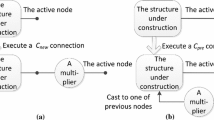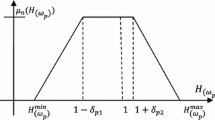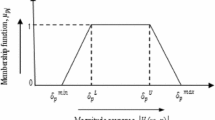Abstract
This paper proposes a subsystem-based structure evolution algorithm for stable IIR digital filter design. The method designs the IIR digital filter through optimizing the filter structure. A filter structure is defined as the connection of the subsystems. A subsystem is a 2-order IIR digital structure with uncertain parameters. Subsystems are randomly connected with the constraints of no feedback branches between subsystems. The subsystem’s parameters and the connections between subsystems are optimized by evolutionary algorithms. An adaptive multiple-elites-guided composite differential evolution algorithm (AMECoDEs) is used to optimize this problem. Four classic types of filters, lowpass, highpass, bandpass and bandstop filters are designed. Five state-of-the-art evolutionary algorithms are compared. The simulation results show that AMECoDEs holds the first place on comprehensive performance and convergence rate. At the same time, the poles of filters all reside within the unit circle, which validates the stability of the IIR digital filters.

























Similar content being viewed by others
References
Agrawal N, Kumar A, Bajaj V (2017) Design of digital IIR filter with low quantization error using hybrid optimization technique. Soft Comput 22(9):2953–2971
Agrawal N, Kumar A, Bajaj V (2018) Design of Bandpass and Bandstop infinite impulse response filters using fractional derivative. IEEE Trans Ind Electron 66(2):1285–1295
Chen C (1979) One-dimensional digital signal processing. Marcel Dekker, New York
Chen S, Istepanian R, Luk B (2001) Digital IIR filter design using adaptive simulated annealing. Dig Signal Process 11(2):241–251
Cui L, Li G, Zhu Z, Lin Q, Wong K-C, Chen J, Lu N, Lu J (2018) Adaptive multiple-elites-guided composite differential evolution algorithm with a shift mechanism. Inf Sci 422:122–143
Dai C, Chen W, Zhu Y (2010) Seeker optimization algorithm for digital IIR filter design. IEEE Trans Ind Electron 57(5):1710–1718
Feng S, Chen L, Liu M (2018) Random structures based design method for multiplierless IIR digital filters. J Comput Appl 9:2621–2625
Guo SM, Yang CC, Hsu PH (2015) Improving differential evolution with a successful-parent-selecting framework. IEEE Trans Evolut Comput 19(5):717–730
Jackson L (2000) A correction to impulse invariance. Signal Process Lett IEEE 7(10):273–275
Karaboga N (2005) Digital IIR filter design using differential evolution algorithm. EURASIP J Appl Signal Process 2005(8):1269–1276
Karaboga N, Kalinli A, Karaboga D (2004) Designing digital IIR filters using ant colony optimisation algorithm. Eng Appl Artif Intell 17:301–309
Manoj V, Elias E (2009) Design of multiplier-less nonuniform filter bank transmulti-plexure using genetic algorithm. Signal Process 89(11):2274–2285
Narasimhan S, Veena S (2005) Signal processing: principles and implementation. Alpha Science Int’l Ltd, New Delhi
Pan ST (2011) Evolutionary computation on programmable robust IIR filter pole-placement design. IEEE Trans Instrum Meas 60(7):1469–1479
Parks W, Burrus C (1987) Digital filter design. Wiley, Hoboken
Prince S, Kumar KRS (2018) A novel Nth-order IIR filter-based graphic equalizer optimized through genetic algorithm for computing filter order. Soft Comput 23(8):2683–2691
Saha SK, Kar R, Mandal D, Ghoshal SP (2014) Harmony search algorithm for infinite impulse response system identification. Comput Electr Eng 40(4):1265–1285
Saha S, Kar R, Mandal D, Ghoshal S (2015) Optimal IIR filter design using gravitational search algorithm with wavelet mutation. J King Saud Univ Comput Inf Sci 27(1):25–39
Sarangi A, Sarangi SK, Padhy SK, Panigrahi SP, Panigrahi BK (2014) Swarm intelligence based techniques for digital filter design. Appl Soft Comput 25(C):530–534
Shafaati M, Mojallali H (2018) IIR filter optimization using improved chaotic harmony search algorithm. Automatika 59(3):332–340
Singh CR, Arya SK (2013) An optimal design of IIR digital filter using particle swarm optimization. Appl Artif Intell 27(6):429–440
Tong L, Dong M, Jing C (2018) An improved multi-population ensemble differential evolution. Neurocomputing 290:130–147
Wang Y, Li B, Chen Y (2011) Digital IIR filter design using multi-objective optimization evolutionary algorithm. Appl Soft Comput 11(2):1851–1857
Wang Y, Li B, Weise T (2013) Two-stage ensemble memetic algorithm: function optimization and digital IIR filter design. Inf Sci 220:408–424
Wu G, Mallipeddi R, Suganthan P, Wang R, Chen H (2016) Differential evolution with multi-population based ensemble of mutation strategies. Inf Sci 329:329–345
Zhu W, an Fang J, Tang Y, Zhang W, Du W (2012) Digital IIR filters design using differential evolution algorithm with a controllable probabilistic population size. PLoS One 7(7):266–266
Funding
This study was Funded by 15A510018, 15A510019, 12A510002, 142102 210629, 2008YBZR028 and ZZJJ20140037.
Author information
Authors and Affiliations
Corresponding author
Ethics declarations
Conflict of interest
Author Lijia Chen declares that he has no conflict of interest. Author Mingguo Liu declares that he has no conflict of interest. Author Zan Wang declares that she has no conflict of interest. Author Zhen Dai declares that he has no conflict of interest.
Ethical approval
This article does not contain any studies with human participants or animals performed by any of the authors.
Informed consent
Informed consent was obtained from all individual participants included in the study.
Additional information
Communicated by V. Loia.
Publisher's Note
Springer Nature remains neutral with regard to jurisdictional claims in published maps and institutional affiliations.
Rights and permissions
About this article
Cite this article
Chen, L., Liu, M., Wang, Z. et al. A structure evolution-based design for stable IIR digital filters using AMECoDEs algorithm. Soft Comput 24, 5151–5163 (2020). https://doi.org/10.1007/s00500-019-04268-w
Published:
Issue Date:
DOI: https://doi.org/10.1007/s00500-019-04268-w




